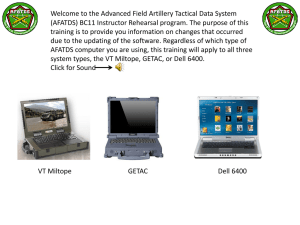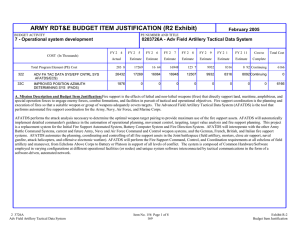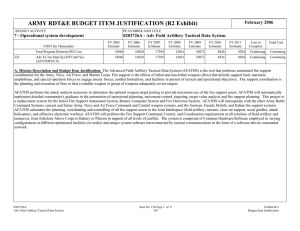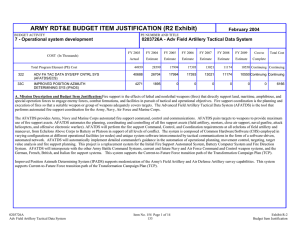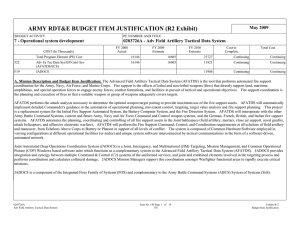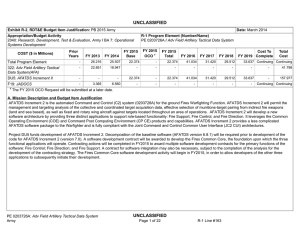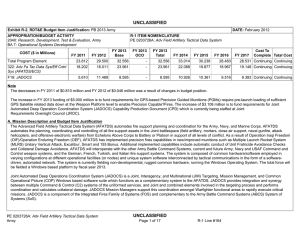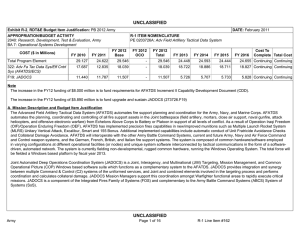T AFATDS: The Fire Support Window to the 21 Century
advertisement
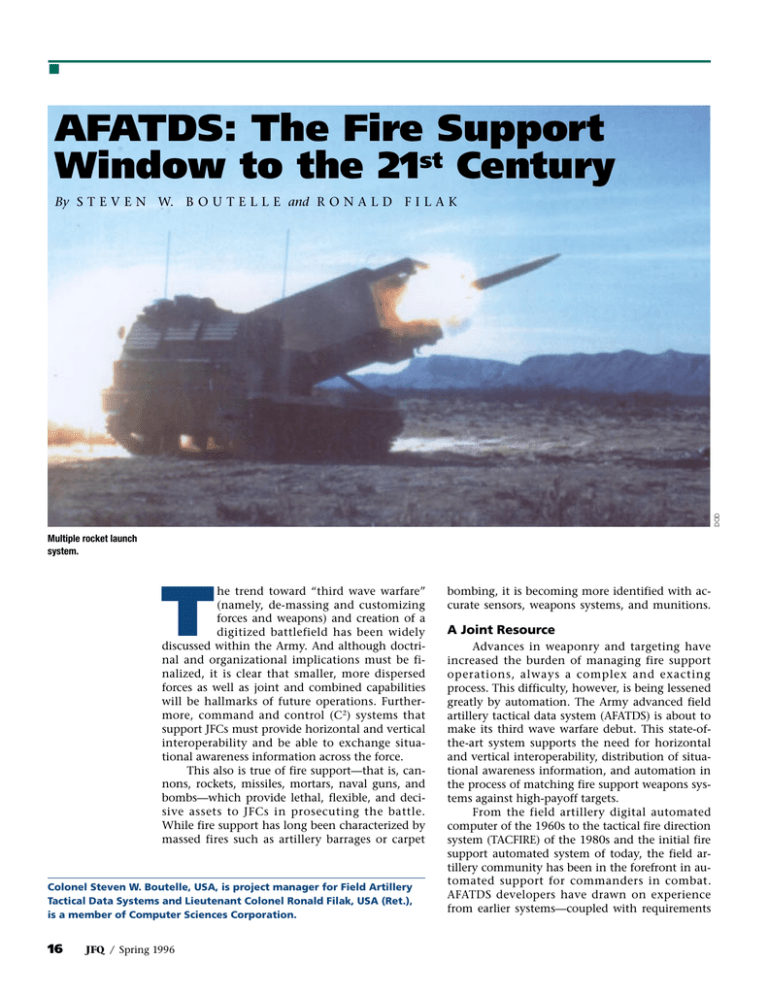
■ AFATDS: The Fire Support Window to the 21st Century DOD By S T E V E N W. B O U T E L L E and R O N A L D F I L A K Multiple rocket launch system. T he trend toward “third wave warfare” (namely, de-massing and customizing forces and weapons) and creation of a digitized battlefield has been widely discussed within the Army. And although doctrinal and organizational implications must be finalized, it is clear that smaller, more dispersed forces as well as joint and combined capabilities will be hallmarks of future operations. Furthermore, command and control (C2) systems that support JFCs must provide horizontal and vertical interoperability and be able to exchange situational awareness information across the force. This also is true of fire support—that is, cannons, rockets, missiles, mortars, naval guns, and bombs—which provide lethal, flexible, and decisive assets to JFCs in prosecuting the battle. While fire support has long been characterized by massed fires such as artillery barrages or carpet Colonel Steven W. Boutelle, USA, is project manager for Field Artillery Tactical Data Systems and Lieutenant Colonel Ronald Filak, USA (Ret.), is a member of Computer Sciences Corporation. 16 JFQ / Spring 1996 bombing, it is becoming more identified with accurate sensors, weapons systems, and munitions. A Joint Resource Advances in weaponry and targeting have increased the burden of managing fire support operations, always a complex and exacting process. This difficulty, however, is being lessened greatly by automation. The Army advanced field artillery tactical data system (AFATDS) is about to make its third wave warfare debut. This state-ofthe-art system supports the need for horizontal and vertical interoperability, distribution of situational awareness information, and automation in the process of matching fire support weapons systems against high-payoff targets. From the field artillery digital automated computer of the 1960s to the tactical fire direction system (TACFIRE) of the 1980s and the initial fire support automated system of today, the field artillery community has been in the forefront in automated support for commanders in combat. AFATDS developers have drawn on experience from earlier systems—coupled with requirements Boutelle analysis and ongoing feedback from soldiers and marines in the field and advanced warfighting experiments—to develop a C2 system responsive to a commander’s needs by supporting: ■ the integration of all fire support assets into the planning and execution of support for the maneuver commander’s operation ■ the application of commander’s guidance to prioritize targets, enabling fire support assets to be directed at the most relevant and important enemy assets ■ the automated exchange of digitized target information and situational awareness with other units throughout the joint force. While AFATDS was originally an Army system, it is now joint and under development by the Army for its own requirements and those of the Marine Corps. A major portion of version 2 development incorporates Marine-unique requirethe Armed Forces are taking ments. Furthermore, prea quantum leap in conducting liminary discussions are unfire support operations in aid derway on the applicability of the “core software enof a single service or JFC gine” of AFATDS to the fire support roles of the Air Force and Navy. This article discusses operational, technical, and interoperability features of AFATDS that provide JFCs and fire support coordinators (FSCOORDs) with these capabilities. Operational With AFATDS, the Armed Forces and fire support community are taking a quantum leap in the ability to provide timely help for conducting fire support operations in aid of a single service or JFC. The operational capability of AFATDS is made up of 27 major functional capabilities in five functional categories. The breadth of fire support functionality and horizontal interoperability of AFATDS make it the most comprehensive information warfare combat system available. The fire support planning function provides FSCOORDs with several key capabilities. First, since the concepts of operation and guidance are entered into its database, AFATDS can assist in performing course of action analysis on alternative battle plans. Operators can adjust any combination of variables to identify the impact of the changes on the ability of fire support to sustain a commander’s plans. The same degree of flexibility allows for the application of analysis against several options proposed by JFCs to determine which plan is most supportable from a fire support perspective. AFATDS performs this analysis using information on all types of available fire support: air attack (including attack helicopter and fixed-wing close air support), naval gunfire, mortars and offensive electronic warfare, as well and Filak as field artillery assets (cannons, rockets, and missiles). This automated analysis process also enables a fire support commander to automatically generate and digitally distribute fire support annexes and plans. Second, the exchange of situational awareness information allows AFATDS to constantly provide up-to-date graphic depictions of battlefield information. This provides commanders timely information with which to formulate or adjust guidance while eliminating the need to transport and post (via grease pencils and tape) bulky situation maps. Target Acquisition Since it is interoperable with a variety of C2 systems, AFATDS provides commanders with major advances in the ability to see the battlefield and plan future operations. Intelligence collection systems can develop large amounts of data on potential targets throughout a battlefield. AFATDS provides commanders interoperability with the all source analysis system (ASAS), an automated Army C 2 system used by the intelligence/electronic warfare community. ASAS, in turn, provides access to targeting information via Trojan Spirit and tactical intelligence collection systems. Trojan Spirit offers a communications gateway to national intelligence databases and multiservice tactical intelligence systems including material from the Central Intelligence Agency, Defense Intelligence Agency, and National Security Agency, as well as tactical target data from systems such as the joint surveillance target attack radar system (JSTARS), the Guardrail and Rivet Joint electronic intelligence collection systems, and the Air Force tactical reconnaissance aircraft (see figure on next page). Planning At the same time weapon systems are becoming more capable of attacking identified targets with pin-point accuracy. It may no longer be necessary to launch a wave of bombers or mass an attack by tube artillery to take out a critical target. Instead, planners—through the AFATDS– ASAS interoperability capability—can open the door to a storehouse of available targeting information and use automated target analysis and target attack capability from AFATDS to match weapons assets against selected targets. If a situation warrants—against tactical missiles such as Scuds—this can be done in seconds and without human intervention. While providing access to this vast array of information, AFATDS also uses distribution criteria and graphic overlay filters to ensure that users Spring 1996 / JFQ 17 ■ FIRE SUPPORT WINDOW National, Strategic, and Tactical Sensors Linked to Fire Support Weapons Systems. TIBS TR-1 NATIONAL ASSETS JSTARS GROUND PROCESSING FACILITY GROUND STATION MODULE MLRS MLRS (ATACMS-Equipped) TROJAN SPIRIT AFATDS ASAS MLRS FIRE DIRECTION CENTER receive only needed information. Operator controlled distribution lists filter the information which is conveyed by AFATDS to its subordinate stations. For example, an AFATDS operator can establish distribution criteria for remote stations that will provide only information of importance. Although vast amounts of information reside in the AFATDS computer, map, and overlay tools, human interfaces have been designed so that operators can selectively screen AFATDS allows JFCs or their information. Examples include multiple tactical overrepresentatives to centrally lays with varying parameters as well as the ability to control control fires by approving the area depicted by scrolling each mission and zooming to portray different information. Both operators and commanders can select the information and area they want to view. Moreover, potential targets can be portrayed graphically and, at an operator’s discretion, additional information on targets can be viewed by clicking on an icon and reviewing database entries. The AFATDS database contains data which is relevant to all levels of command. However, the information routinely portrayed at a field artillery or maneuver battalion level likely differs from that portrayed at division or corps level. AFATDS addresses this situation by providing operators with the ability to establish parameters on the scope (breadth of information) and granularity (depth of information) that is routinely presented. By monitoring activities down two levels, 18 JFQ / Spring 1996 AFATDS operators in a corps fire support element (FSE) normally observe status down to the battalion level. However, the AFATDS database has information on firing platoons and batteries that constitute each battalion. This data is successively “rolled up” to develop status on the battalion. Corps FSE operators can institute a parameter that tells the computer to distill the information on subordinate units and report status at battalion level. (Concurrently, counterparts at division FSE or division artillery level can establish parameters, with the same database, at battery or firing platoon level.) Corps FSE operators can change a parameter to allow insight into specific information that applies to any of the firing platoons within a given area. The fire support execution portion of AFATDS implements many functions which have not been previously automated. In providing automated target analysis—ensuring that the right target is engaged at the right time by the right weapon/ammunition mix—AFATDS offers major increases in speed fire mission processing. (Performance tests indicate that AFATDS processes missions in 10 to 50 percent of the time for Army training standards.) Fire support execution features include: ■ elimination of “first in, first out” processing and engaging of targets: target management matrix and high payoff target list tools provide for sensor inputs to be matched against concept of the operation and fire support guidance to move important targets to the front of the queue ■ a database of unit information, extant battlefield geometry, and fire support coordination measures to verify that target engagement complies with restrictions and guidance criteria ■ software that automatically assesses the capabilities of each available type of fire support weapon system: weapon status, ammunition effectiveness and availability, commander’s guidance (such as limits on selected units to conserve ammunition), and factors which determine the optimal means of engaging a target and generating an “order to fire” for selected units to engage. AFATDS is designed to provide JFCs, FSCOORDs, and system operators with flexibility in responding to emerging needs. Each of its features is directly controlled by operator inputs. In all cases, operators have the option of inputting parameters that identify the points and conditions at which human intervention and decisions are required to continue the process. This allows JFCs or their representatives to centrally control fires by approving each mission or, conversely, to provide more decentralized execution by enabling missions that meet certain criteria to automatically be forwarded without human intervention. U.S. Army Boutelle Battle command vehicle with ASAS. The remaining AFATDS functions are movement control, field artillery mission support, and field artillery fire direction operations. Movement control provides the ability to request and coordinate convoy movements while the field artillery mission support furnishes logistical backing. Field artillery fire direction operations bolster the fire support execution function by maintaining the status of weaponry, ammunition, and unit capability, and by making technical fire direction calculations. Technical Concepts AFATDS will ultimately become a part of the Army battle command system (ABCS), an overarching scheme conceived as the keystone of a digitized battlefield. When developed, it will furnish seamless connectivity from the tactical (squad/platoon) to strategic level (national command authorities), ensuring an integrated digital information network to support warfighting systems and C2 decision-cycle superiority. This system will be realized by a migration of systems— including the current Army tactical command and control system (ATCCS)—using both an evolutionary and transitional process. Today, AFATDS is one of five battlefield functional area (BFA) control systems that make up ATCCS. As with all ATCCS BFA control systems, AFATDS makes use of ATCCS common hardware and software. Under this concept, a project manager provides the ATCCS component systems with a suite of common computers and peripheral devices on which to host their respective BFA-specific applications software. The project manager for common hardware and software also provides common support software for basic and Filak functions (such as operating system, graphical user interface, and communications management) as well as modules for common applications (such as terrain evaluation). This support software is being upgraded to meet joint standards for a common operating environment with automated information systems to increase interoperability. This will help assure that commanders or their staffs can, from any terminal, access the common picture of the battlefield and communicate with other operational facilities, regardless of service. Fire support-specific software has been integrated with ATCCS hardware and software to form AFATDS. Fire support software is modular, user friendly, and can be tailored. In addition, it includes an embedded training module. The whole package is integrated in wheeled and tracked shelters developed under the ATCCS standard integrated command post system program. Shelters have one, two, or three AFATDS workstations, depending on mission requirements. Throughout the development process, the hardware platform housing AFATDS has been consistently upgraded to state of the art. Initial fielding of AFATDS will be on a Hewlett-Packard 735 reduced instruction set computing machine; subsequent fielding will be on a Sun Sparc dual processor terminal. These configurations offer a tremendous computing potential for meeting the challenges of the dispersed Force XXI battlefield. The operational fire support requirements were thorough and accurate. The nature of the threat, doctrine, force structure, missions, and technology have dramatically changed since initial development in the mid-1980s. With these changes has come the need for AFATDS to evolve to address future requirements. This has been done through involving AFATDS in training exercises and advanced warfighting experiments. AFATDS was designed to operate with all standard Army tactical communications systems. Within an operational facility, AFATDS terminals share data using an internal local area network. In a maneuver command post, AFATDS exchanges information with other components of ATCCS using local area network. For communications between command posts, AFATDS transmits and receives information on the single channel ground and airborne radio system, enhanced position location reporting system, and mobile subscriber equipment packet network. Operating with these systems gives AFATDS a high degree of flexibility in satisfying its communications needs. The challenge of minimizing bandwidth usage has also been met. For AFATDS–AFATDS communication, transfer syntax is employed to update the databases of remote stations. Under this technique, all data items are time-stamped Spring 1996 / JFQ 19 FIRE SUPPORT WINDOW DOD ■ JSTARS aircraft. and only those which have changed since the last update are sent. For communication with nonAFATDS stations, the variable message format (VMF) is used in lieu of the U.S. message text format (USMTF). Studies indicate that VMF messages yield bandwidth utilization savings of 50 percent over the USMTF format. The technical design of AFATDS meets Army goals for commonality and interoperability and fully promotes fire support mission requirements. Interoperability AFATDS is designed to be interoperable with various systems and subsystems and to exchange information with other ATCCS elements, namely, the maneuver control system, combat service support control AFATDS V2 will include system, and forward area air deautomation processes fense command and control sysrelated to requesting and tem, in addition to ASAS. This includes utilizing messages that executing close air conform to USMTF and joint VMF standards, and database support missions transfer processes which employ distributed computing environment and data distribution services software. Using messages that conform to the TACFIRE or VMF standard, AFATDS can exchange information in the fire support community, including fire direction for the multiple launch rocket system (MLRS), cannon battery computer system, and 20 JFQ / Spring 1996 JSTARS ground station module. With messages that observe a four-nation common technical interface design plan, AFATDS is interoperable with British, French, and German automated fire support C2 systems. The design plan was framed by these nations under the auspices of the artillery systems cooperation activities program. The basis of the technical interface is a common tactical concept document also developed under the program. The common tactical concept emphasizes a commitment to ensuring that all four nations are able to conduct fire support operations on a combined basis. Using messages conforming to the TACFIRE and VMF message standards, AFATDS can exchange information with emerging systems such as the combat vehicle command and control system. In the future AFATDS will interoperate directly with overhead sensor systems via the commanders’ tactical terminal (until that capability is provided, AFATDS will get that information through ASAS). Program Outline AFATDS development is a phased effort. The first phase will yield AFATDS version 1 software that automates half of the Army’s fire support operational requirements. The next phase is divided into subphases and will result in AFATDS version 2.0 and 2.1 software. Operationally, version 2.0 software is focused on satisfying requirements established by the Marine Corps while version 2.1 will automate additional Army requirements. While satisfying service-unique needs, this sec- Boutelle ond phase will also incorporate major additional software modules to enhance the ability of AFATDS to participate in joint operations. The inclusion of unified-build software—the heart of the joint global command and control system—provides software compatibility at the joint level for 19 fundamental computer processes ranging from network administration to database management. Aided by the further use of a standard application program, this will help to direct AFATDS towards the ultimate goal of full interoperability with the automated systems of all services. As a result of ongoing work by the Naval Research and Development Center in San Diego, AFATDS V2 capabilities will include automation of processes related to requesting and executing close air support (CAS) and battlefield air interdiction (BAI) missions. This capability will ease the daily coordination and planning of fires with the facility to electronically transmit preplanned and immediate air support requests to the Air Force contingency tactical automated planning system (CTAPS). AFATDS will also be able to receive confirmation of preplanned CAS missions via the CTAPS-produced air tasking order (ATO). The operator can parse, store, and display ATO data by sortie type (such as CAS, BAI, or search and rescue) and incorporate sortie data for ATOs in the process of deconflicting air attack missions from cannon, rocket, and missile activity. The final phase (version 3) will lead to the production of the AFATDS objective system. This phase will automate remaining operational fire support requirements and incorporate technical fire direction functionality currently resident in the battery computer system (for cannon operations) and the fire direction system (for rocket and missile operations). AFATDS version 1 software underwent initial operational testing and evaluation in August 1995 and a Milestone III production decision was made by the Army System Acquisition Review Council (ASARC) in December 1995. The 1st Cavalry Division, as an operational test unit, has AFATDS Beta software and will become the first organization in the field to receive version 1. After ASARC III, it was fielded to elements of the 4th Infantry Division comprising the EXFOR (Task Force XXI). Employment To ensure that the design meets the requirements of warfighters, AFATDS has been placed with units and taken part in advanced warfighting experiments. The 1 st Cavalry Division received the system in July 1993 and has taken it and Filak through force development test and experimentation, field and command post exercises, and rotations at the National Training Center. Moreover, the division used AFATDS in Kuwait from August to October 1995 during Exercise Intrinsic Action. Feedback has led to improved human interface and selected operational characteristics. In Germany, V Corps headquarters employed AFATDS during Atlantic Resolve in 1994. As a direct result, implementation of a deep strike support capability, first scheduled for version 3, was accelerated, and AFATDS currently can support emerging operational requirements such as attack on hostile tactical missile launchers. AFATDS is the fire support command, control, and coordination system of choice for the following advanced warfighting experiments: Prairie Warrior (Fort Leavenworth), Warrior Focus (a Joint Readiness Training Center experiment at Fort Polk with the 10th Mountain Division), and a theater missile defense experiment at Fort Bliss during Roving Sands. Each advanced warfighting experiment allowed AFTADS developers to refine functional and interoperability capabilities. More recently, AFTADS was used during CJTF Exercise (CJTFEX) ’96 which involved more than 53,000 British and U.S. personnel in the southeastern United States and along the eastern seaboard. The Task Force XXI advanced warfighting experiment slated for February 1997 will be the first event designed to survey the Army digitization concept on a wide scale. A brigade-plus of the 4th Infantry Division will be outfitted with computers and force management software. AFATDS will be fielded to two dozen operational facilities that deploy with the maneuver forces (including FSEs, officer vehicles, and combat observationliaision teams) and ten operational facilities that are designated to support field artillery operations (including battalion and platoon fire direction centers and field artillery battalion commanders, S–2s, and S–3s). The software delivered has been modified for the VMF message set designed for Task Force XXI operations. AFATDS is an automated tool that will assist both JFCs and FSCOORDs in managing and assessing large amounts of available information and making effective use of forces and weapons. In meeting the operational needs of today, AFATDS offers the flexibility to support the evolving requirements of Force XXI doctrine and third wave warfare. JFQ Spring 1996 / JFQ 21
